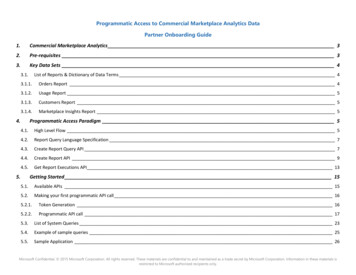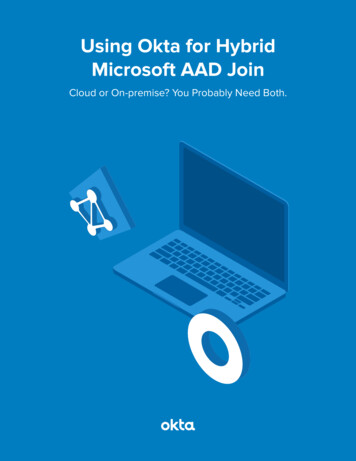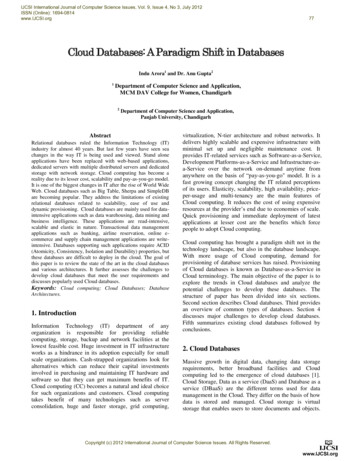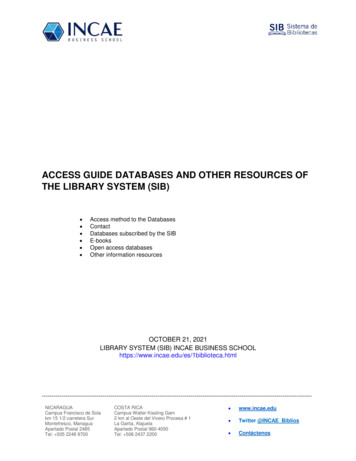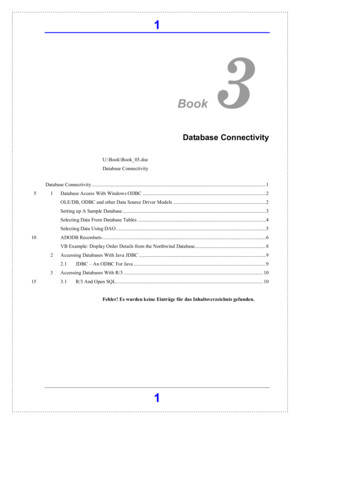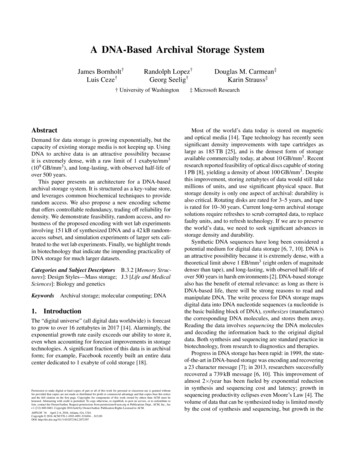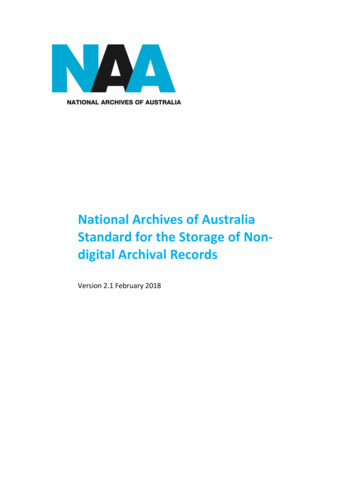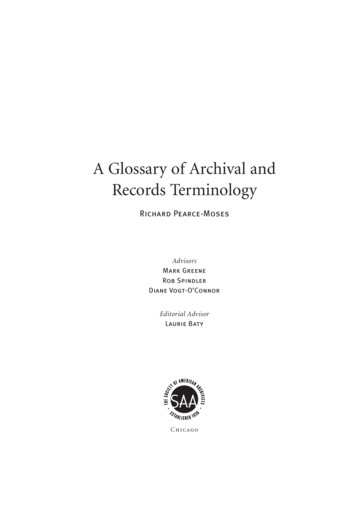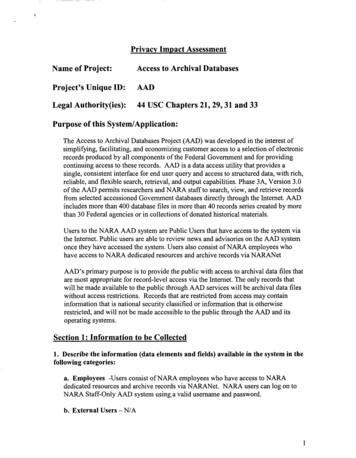
Transcription
Priyacy Impact AssessmentName of Project:Access to Archiyal DatabasesProject's Unique ID:AADLegal Authority(ies):44 USC Chapters 21, 29,31 and 33Purpose of this System/Application:The Access to Archival Databases Project (AAD) was developed in the interest ofsimplifying, facilitating, and economizing customer access to a selection of electronicrecords produced by all components of the Federal Govemment and for providingcontinuing access to these records. AAD is a data access utility that provides asingle, consistent interface for end user query and access to stmctured data, with rich,reliable, and flexible search, retrieval, and output capabilities. Phase 3A, Version 3.0of the AAD permits researchers and NARA staff to search, view, and retrieve recordsfrom selected accessioned Govemment databases directly through the Intemet. AADincludes more than 400 database files in more than 40 records series created by morethan 30 Federal agencies or in collections of donated historical materials.Users to the NARA AAD system are Public Users that have access to the system viathe Intemet. Public users are able to review news and advisories on the AAD systemonce they have accessed the system. Users also consist of NARA employees whohave access to NARA dedicated resources and archive records via NARANetAAD's primary purpose is to provide the public with access to archival data files thatare most appropriate for record-level access via the Intemet. The only records thatwill be made available to the public through AAD services will be archival data fileswithout access restrictions. Records that are restricted from access may containinfomiation that is national security classified or information that is otherwiserestricted, and will not be made accessible to the public through the AAD and itsoperating systems.Section 1: Information to be Collected1. Describe the information (data elements and fields) available in the system in thefollowing categories:a. Employees -Users consist of NARA employees who have access to NARAdedicated resources and archive records via NARANet. NARA users can log on toNARA Staff-Only AAD system using.a valid usemame and password.b. External Users - N/A
c. Audit trail information (including employee log-in information) - To theextent that information and data is captured as part of the logs in the AAD system, thesystem administrator conducts ad hoc queries and provide reports of a security anddata integrity nature as requested by the NARA AAD Project Manger.The System Administrator utilizes Oracle Auditing Tools to look for anyunauthorized changes to monitored data tables associated with agency electronicrecords or to detect any unauthorized changes on both the public and NARA Staffonly databases.The System Administrator verifies the integrity of the AAD applications code in theboth the public and NARA staff-only subsystem using a digital signature mechanism.d. Other (describe) ) - Users to the NARA AAD system are Public Users that haveaccess to the system via the Intemet. Public users are able to review news andadvisories on the AAD system once they have accessed the system.2. Describe/identify which data elements are obtained from files, databases,individuals, or any other sources?a. NARA operational records -N/Ab. External users - N/Ac. Employees - N/Ad. Other Federal agencies (list agency) Federal agencies are the originators ofarchival records that are available via AAD. Some records submitted containpersonally identifiable information. However, personal information is masked frompublic disclosure consistent with the provisions of the Freedom of Information Act (5U.S.C. 552), and only the masked versions of the archival records are provided to theAAD contractor for loading into AAD.e. State and local agencies (list agency) - N/Af. Other third party source - N/ASection 2: Why the Information is Being Collected1. Is each data element required for the business purpose of the system? Explain.Yes. User data is needed to establish and maintain user profiles for access to thestaff-only portion of the AAD, which restrict access to system features as appropriate.
2. Is there another source for the data? Explain how that source is or is not used?NoSection 3: Intended Use of this Information1. Will the system derive new data or create previously unavailable data about anindividual through aggregation from the information collected, and how will this bemaintained and filed?No2. Will the new data be placed in the individual's record?N/A3. Can the system make determinations about employees/the public that would notbe possible without the new data?N/A4. How will the new data be verified for relevance and accuracy?Data in AAD that is publicly available has been verified against the explanatorydocumentation provided at transfer, i.e., during accession processing. This stepprecedes any preparation of the records for loading into AAD. Data is not furtherverified for accuracy or timeliness; it is assumed to be accurate and timely at the timeof transfer from the originating agency.5. If the data is being consolidated, what controls are in place to protect the datafrom unauthorized access or use?N/A6. If processes are being consolidated, are the proper controls remaining in place toprotect the data and prevent unauthorized access? Explain.N/A7. Generally, how will the data be retrieved by the user?Users to the NARA AAD system are Public Users that have access to the system viathe Intemet. Public users are able to review news and advisories on the AAD systemonce they have accessed the system. Data is retrieved through standardized and adhoc queries against a database. The only records available to the public through AADare data files without access restrictions.
8. Is the data retrievable by a personal identifier such as a name, SSN or otherunique identifier? If yes, explain and list the identifiers that will be used to retrieveinformation on an individual.As stated above, AAD maintains data transferred to NARA from various federalagencies. It is likely that upon transfer, some data may contain personally identifiableinformation, including social security numbers or other unique identifiers. However,no restricted information is made available through AAD. Only publicly availabledata can be accessed through AAD.9. What kinds of reports can be produced on individuals? What will be the use ofthese reports? Who will have access to them?No reports are produced on individual AAD users.10. Can the use of the system allow NARA to treat the public, employees or otherpersons differently? If yes, explain.No.11. Will this system be used to identify, locate, and monitor individuals? If yes,describe the business purpose for the capability and the controls established explain.No.12. What kinds of information are collected as a function of the monitoring ofindividuals?N/A13. What controls will be used to prevent unauthorized monitoring?N/A14. If the system is web-based, does it use persistent cookies or other trackingdevices to identify web visitors?No.
Section 4: Sharing of Collected Information1. Who will have access to the data in the system (e.g., contractors, users, managers,system administrators, developers, other)?Users and authorized contractors will have access to all data in AAD. Public userswill have access to the publicly available records in AAD through the intemet.2. How is access to the data by a user determined and by whom? Are criteria,procedures, controls, and responsibilities regarding access documented? If so,where are they documented (e.g., concept of operations document, etc.).Access is determined by the system administrator based on job duties. Technicalcontrols protect against unauthorized access to, or misuse of, AAD.3. Will users have access to all data on the system or will the user's access berestricted? Explain.Authorized users have access to the data in AAD4. What controls are in place to prevent the misuse (e.g., unauthorized browsing) ofdata by those who have been granted access (please list processes and trainingmaterials)?Technical controls protect against unauthorized access to, or misuse of, AAD andfacilitate detection of security violations by generating audit logs to record users'activities and warn of anomalous conditions in the network. Audit tools create,maintain, and protect a trail of actions of users and administrators that trace securityrelevant events to an individual, ensuring accountability.5. Are contractors involved with the design and development of the system and willthey be involved with the maintenance of the system? If yes, were Privacy Actcontract clauses inserted in their contracts and other regulatory measuresaddressed?Yes, there are clauses that warn against unauthorized disclosure of information fromAAD. Note, however, that the provisions of the Privacy Act do not apply to thearchival data in AAD.6. Do other NARA systems provide, receive or share data in the system? If yes, listthe system and describe which data is shared. If no, continue to question 8.AAD interfaces with several NARA systems. Archival Electronic Records Inspection and Control (AERIC) System
The Archival Electronic Records Inspection and Control (AERIC) system is used toverify the adequacy of the accompanying documentation for the electronic data filestransferred by federal agencies to NARA. Archival Research Catalog (ARC) Interface (ARC)ARC is the online catalog of NARA's nationwide holdings, including those from theWashington, DC area. Regional Archives, and Presidential Libraries. ARC allowsbasic and advanced searching of archival descriptions and information about archivalcreators. APS Interface - Data Export ModuleThis interface is a one-way copy process of updated data from the APS ontoremovable media for uploading into AAD, including new titles, record counts, filebyte sizes, data indicators (e.g., ASCII or EBCDIC), and record lengths, etc. File Transfer Server - File Transfer ServicesThe file transfer servers are used to make file based information, such as agencydocumentation files in PDF file format, available within AAD to users fordovraloading. The file transfer servers can also be used to transfer scatmed documentimages and PDF files from NARA to the AAD contractor. AAD Home Page Interface on NARANETAAD services are launched from the NARA Public Website (www.archives.gov/aad).Currently, all of the AAD help pages, tutorials, and related aids are hosted by thisweb site. AAD maintains the content for these files as HTML fragments on the AADwebsite and provides a URL to NARA where they are then formatted and presentedwithin the frames of the NARA website. Document Store - Scan Documentation (Manual Process using COTSproducts).This program layer produces scanned images of selected agency documents fordelivery online. The choice of scaimer type depends upon the document size, numberof pages, and other factors such as:Image Quality (Skew, Density, Clarity, Distortion, Font Face and Size)Binding of OriginalBackgroundEmbedded ImagesStaples, Holes, Tears, etc.Print Type (Laser, Dot Matrix, Handwritten)Either a large flat bed (11 x 17) scanner, or an HP ScanJet with automatic page feederis used.
Generate PDFThis program layer takes scanned images of the previous program layer and convertsthem into Portable Document Format (PDF) for online delivery.7. Have the NARA systems described in item 6 received an approved SecurityCertification and Privacy Impact Assessment?Yes. A Certification and Accreditation has been performed and is approved and a PIAwas completed in 2007. There have been no design changes, nor any changes tofeatures made since that time.8. Who will be responsible for protecting the privacy rights of the public andemployees affected by the interface?The AAD system owner and individual users are responsible for managing andsecuring any personal data which resides in the system. NARA's Senior AgencyOfficial for Privacy is responsible for ensuring compliance with the privacy rights ofthe public and NARA employees9. Will other agencies share data or have access to the data in this system (Federal,State, Local, or Other)? If so list the agency and the official responsible for properuse of the data, and explain how the data will be used.N/ASection 5: Opportunities for Indiyiduals to Decline ProyidingInformation1. What opportunities do individuals have to decline to provide information (i.e.,where providing information is voluntary) or to consent to particular uses of theinformation (other than required or authorized uses), and how can individualsgrant consent?AAD does not accept data from the public. The only data in AAD are historical datathat have been transferred from other Federal agencies or in donated historicalmaterials for permanent retention by NARA in accordance with the Federal RecordsAct.2. Does the system ensure "due process" by allowing affected parties to respond toany negative determination, prior to final action?N/A. The records in AAD are archival records transferred to the custody of theArchivist of the Untied States for permanent retention. Archival records arespecifically excluded from the access and amendment provisions of the Privacy Act.
Section 6: Security of Collected Information1. How will data be verified for accuracy, timeliness, and completeness? Whatsteps or procedures are taken to ensure the data is current? Name the documentthat outlines these procedures (e.g., data models, etc.).Data in AAD that is publicly available has been verified against the explanatorydocumentation provided at transfer, i.e., during accession processing. This stepprecedes any preparation of the records for loading into AAD. Data is not fiartherverified for accuracy or timeliness; it is assumed to be accurate and timely at the timeof transfer from the originating agency.2. If the system is operated in more than one site, how will consistent use of thesystem and data be maintained in all sites?N/A3. What are the retention periods of data in this system?Data in AAD are records that have been transferred to NARA for permanentretention.4. What are the procedures for disposition of the data at the end of the retentionperiod? How long will the reports produced be kept? Where are the proceduresdocumented? Cite the disposition instructions for records that have an approvedrecords disposition in accordance with, FILES 203. If the records are unscheduledthat cannot be destroyed or purged until the schedule is approved.See above.5. Is the system using technologies in ways that the Agency has not previouslyemployed (e.g., monitoring software, Smart Cards, Caller-ID)? If yes, describe.No.6. How does the use of this technology affect public/employee privacy?N/A7. Does the system meet both NARA's IT security requirements as well as theprocedures required by federal law and policy?Certification and Accreditation has been performed and is reviewed annually byNARA security personnel. The system meets both IT security requirements and allprocedures required by federal law and policy to the best of our knowledge.
8. Has a risk assessment been performed for this system? If so, and risks wereidentified, what controls or procedures were enacted to safeguard theinformation?The last security risk assessment was performed in August, 2007. Any risks requiringmitigation were put into a POAM for the system so that milestones for eliminatingweaknesses could be tracked.9. Describe any monitoring, testing, or evaluating done on this system to ensurecontinued security of information.As part of the normal operations and maintenance of the AAD system, auditing toolsare used to look for any unauthorized changes to data tables associated with agencyelectronic records, AAD applications code, and other unauthorized database actions.System event logs and firewall logs are also monitored for unauthorized access. Inaddition, a subset of NIST 800-53 controls are tested for NARA systems on an atmualbasis.10. Identify a point of contact for any additional questions from users regarding thesecurity of the system.Michael Carlson, DirectorElectronic and Special Media Records Services Division(301)837-1578Michael.Carlson@nara. govMargaret AdamsElectronic and Special Media Records Services Division(301)837-1661Margaret. Adams(a nara. govKermeth Grant, IT Project ManagerElectronic and Special Media Records Services Division(301)837-1661Keimeth. Grant@nara. gov
Section 7: Is this a system of records coyered by the Priyacy Act?1. Under which Privacy Act systems of records notice does the system operate?Provide number and name.Archival records in AAD are specifically excluded from the access and amendmentprovisions of the Privacy Act.2. If the system is being modified, will the Privacy Act system of records noticerequire amendment or revision? Explain.N/AConclusions and Analysis1. Did any pertinent issues arise during the drafting of this Assessment?No2. If so, what changes were made to the system/application to compensate?N/ASee Attached Approval Page10
The Following Officials Have Approved this PIA - u e u / a t(Signature)9/r/o*(Date)Michael Carlson, NWMEAERIC System Owner, Director8601 Adelphi Rd, Room 5320College Park, MD 20740-6001301-837-1578vi ."ut-u. / / / J4JKenneth Grant, NWMEAAD Project Manager8601 Adelphi Rd, Room 5320College Park, MD 20740-6001301-837-1661i:U * - (Signature)hf L l Cmih (Signature) JfVflJf (Date) jsboQ (Date) eo Scanlon, NHIChief Information Security Officer8601 Adelphi Rd, Room 4400College Park, MD ency Official for Privacy8601 Adelphi Rd, Room 3110College Park, MD 20740-6001301-837-3026AfhiJjuMc HMartRaJklorphy, NH V. 'T/Chief Information Officer8601 Adelphi Rd, Room 4400College Park, MD 20740-6001301-837-1992(Signature)(Date)
The Access to Archival Databases Project (AAD) was developed in the interest of simplifying, facilitating, and economizing customer access to a selection of electronic records produced by all components of the Federal Govemment and for providing continuing access to these records. AAD is a data access utility that provides a
